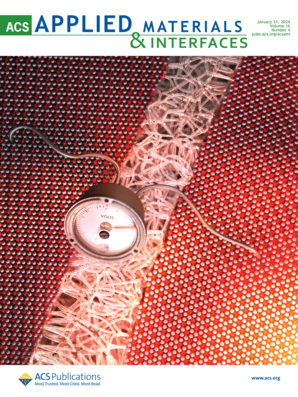一种用于快速定向输水和全方位雾收集的折纸双面膜。
IF 8.3
2区 材料科学
Q1 MATERIALS SCIENCE, MULTIDISCIPLINARY
引用次数: 0
摘要
现有的Janus雾收集技术很难在不同的雾流方向上实现高效和连续的雾收集。在这项工作中,我们开发了一个Janus雾收集(JHL)系统,其特点是通过十八烷硫醇选择性修饰形成无边界的Janus系统,形成一对亲水和疏水结构域。该系统的特点是由扇贝阵列组成的三维折纸宏观结构,形状像改进的喇叭花。润湿性梯度Janus系统可实现快速液滴捕获和超快吸收。多个平行和双不对称的三维Kirigami超亲水通道促进了高速、定向和远程的液体输送。这些机制无缝地协同工作,使超亲水性和疏水性表面始终保持干燥。结果表明,JHL的雾收集效率高达0.83 g·cm-2·min-1,是原始样品的3倍。此外,我们改进的喇叭形3D结构将Janus的设计理念从传统的膜材料扩展到空间膜配置,使其适用于任何雾流环境中的全方位雾收集。本文章由计算机程序翻译,如有差异,请以英文原文为准。
An Efficient Fog Collection Origami Janus Membrane for Rapid Directional Water Transport and Omnidirectional Fog Harvesting.
Existing Janus fog harvesting technologies struggle to achieve efficient and continuous fog collection across various fog flow directions. In this work, we developed a Janus fog harvesting (JHL) system, characterized by a boundary-free Janus system formed by selective modification with octadecanethiol, creating a pair of hydrophilic and hydrophobic domains. The system features a 3D origami macrostructure composed of scallop arrays and shaped like an improved trumpet flower. The wettability gradient Janus system enables rapid droplet capture and ultrafast absorption. The multiple parallel and dual-asymmetric 3D Kirigami superhydrophilic channels facilitate high-speed, directional, and long-range liquid transport. These mechanisms work seamlessly together to keep both the superhydrophilic and hydrophobic surfaces dry at all times. As a result, our JHL achieves a fog harvesting efficiency as high as 0.83 g·cm-2·min-1, which is 3 times that of the original sample. Moreover, our improved trumpet-shaped 3D structure extends the Janus design concept from traditional membrane materials to spatial membrane configurations, making it suitable for omnidirectional fog harvesting in any fog flow environment.
求助全文
通过发布文献求助,成功后即可免费获取论文全文。
去求助
来源期刊

ACS Applied Materials & Interfaces
工程技术-材料科学:综合
CiteScore
16.00
自引率
6.30%
发文量
4978
审稿时长
1.8 months
期刊介绍:
ACS Applied Materials & Interfaces is a leading interdisciplinary journal that brings together chemists, engineers, physicists, and biologists to explore the development and utilization of newly-discovered materials and interfacial processes for specific applications. Our journal has experienced remarkable growth since its establishment in 2009, both in terms of the number of articles published and the impact of the research showcased. We are proud to foster a truly global community, with the majority of published articles originating from outside the United States, reflecting the rapid growth of applied research worldwide.
 求助内容:
求助内容: 应助结果提醒方式:
应助结果提醒方式:


